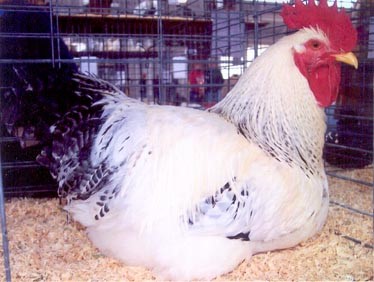Delaware Chickens
were originally developed for commercial, dual-purpose use but later they were
replaced by hybrids. Delawares today make excellent backyard chickens. They
typically lay four, large, brown eggs a week far into the winter months.
Delawares mature quickly and produce a clean, white-meat table fowl. Chicks
develop feathers quicker than most breeds. They handle both cold and heat well.
Unlike present day commercial breeds, they do well as a free-range, foraging
chicken. Delawares have dwindled to a few hundred birds. Many breeders keep
them today with the goal of preserving the Delaware as one of America's
heritage breeds.
Delawares bear
confinement well. Generally a docile breed, Delawares get along with each other
and their humans. They submit to handling without a fuss. However, the
occasional rooster will exercise his rights to aggressive behavior. Owners
describe the hens as broody but good mothers. On the whole Delawares have a
mild, quiet, and calm disposition suitable to the backyard chicken farmer. They
possess all the potential of a commercial breed with all the personality of a
backyard chicken.
Delawares, unlike
many chickens, have only one variety—the Barred Silver Columbian. The roosters
weighs eight pounds and the hens six. They both have predominantly white
plumage. The roosters have black bars on their white tail feathers. The hens
have black tail feathers with white lacing. Both genders have black baring in
their hackles. They sport moderately large pea combs and wattles. The roosters
have a very impressive red, five-point comb. Delaware hens have smaller combs. They
are robust, muscular, and substantial.
They are adaptable
to hot or cold and make a good choice for the first-time chicken rancher.
Protect their large comb and wattles during cold spells. Some breeders have
used an application of petroleum jelly as temporary protection against
frostbite. For long-term protection build an insulated, draft-free coop. Take
advantage of the Delaware's dual-purpose status. Provide good layers good
bedding and artificial lighting for maximum egg output. Delawares came on the
poultry scene relatively late in agriculture history and had little chance to
establish themselves prior to the onset of hybrid breeds. Help establish and
propagate this heritage breed.

